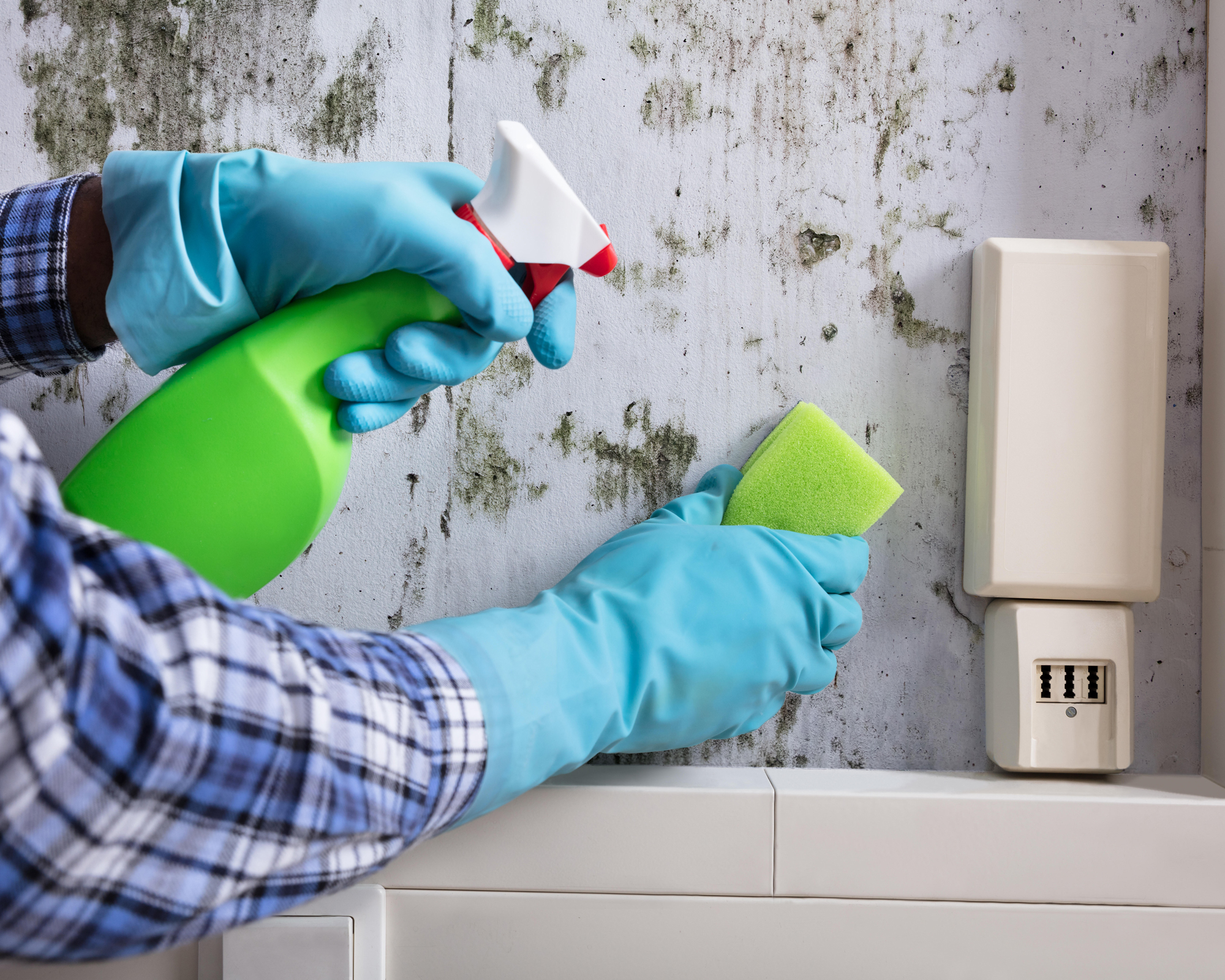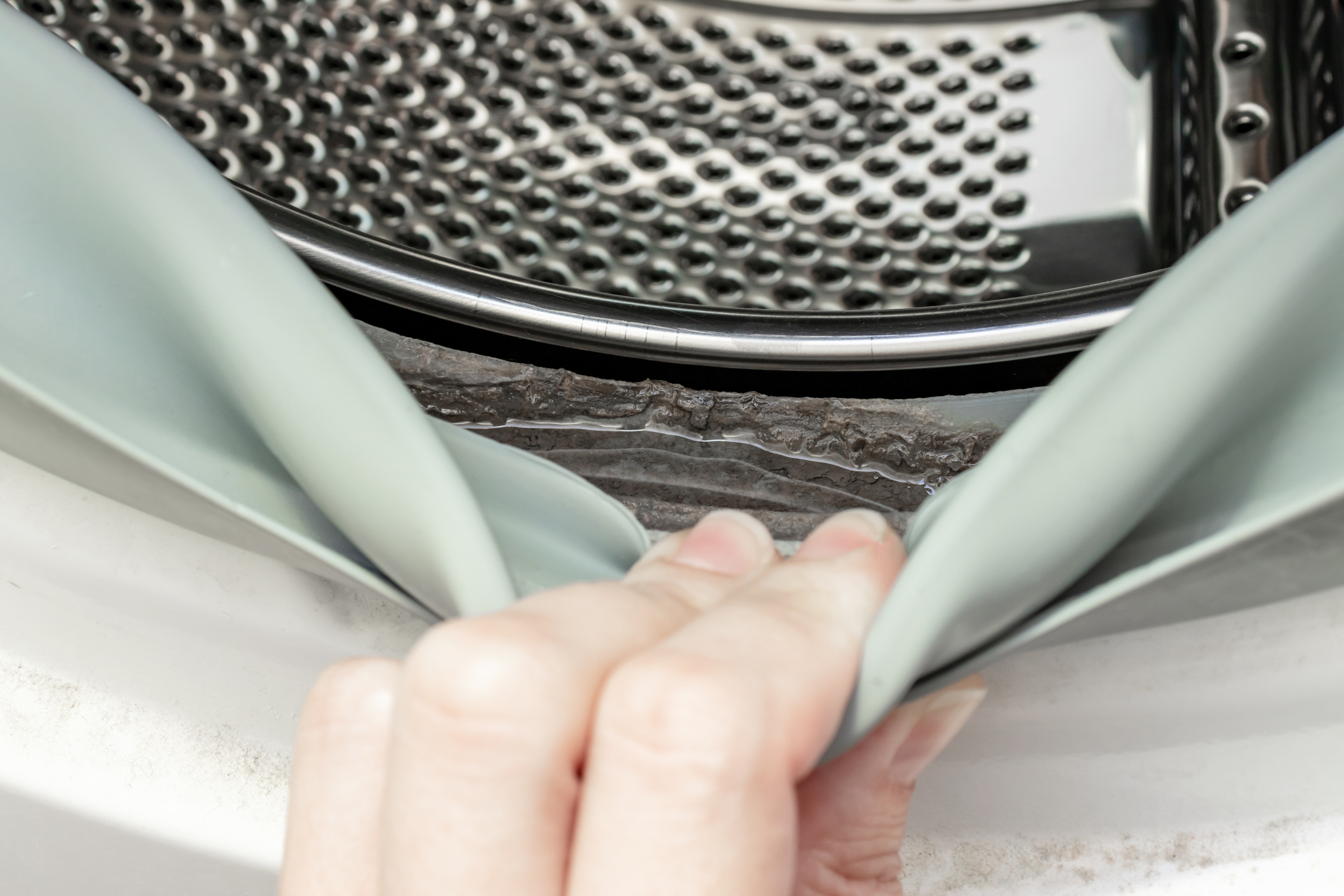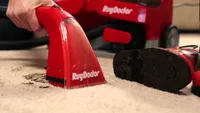How to get rid of mold – effective methods for different home surfaces
Find out how to get rid of mold in the house yourself or whether it's time to call in a professional.


Finding out how to get rid of mold and mildew is essential if you've noticed it in your home. Mold is not just an annoying, unsightly problem but, it can affect your health and should always be dealt with promptly. Tackling mold as soon as it has appeared will give you the best chance of eliminating the problem before having to call in professional help.
Before you start clearinging mold from your home's surfaces, it's important to find out the cause of it to stop any future reoccurrences.
What is mold and what are the causes?
Mold is a fungus, and is caused by excess moisture in the air gathering on surfaces. Mildew is the most common type of mold found in homes and tends to grow in warm, damp places. So you'll often end up getting rid of mold when you're cleaning a bathroom or basement. Mildew will, over time, discolor and damage surfaces.
What's causing your home's mold and mildew? Here's what to investigate:
- Leaking pipes that may need repairing;
- Rising damp in basements or ground floors;
- Rain seeping in because of damage to the roof or around window frames;
- A new extension that's still drying out;
- Condensation on windows and in other areas
How to detect mold and mildew in your home
Mildew often goes unnoticed when it first begins to grow – as a grey or white powdery substance – but once it turns black or brown, it's more obvious. You can check that you're dealing with mildew by applying a tiny amount of bleach – if it's dirt, it will lighten or disappear; if it's mildew, it will be more resistant.
You might also detect mildew through a musty smell, too. As soon as you detect the smell, investigate.

Can you remove mold by yourself?
If you catch an infestation early, then you can tackle mold yourself, but you should protect yourself from mold spores by wearing goggles, rubber gloves and a mask over your nose and mouth. Keep the space well ventilated by opening windows, but keep doors closed to prevent spores spreading to other rooms.
Get small space home decor ideas, celeb inspiration, DIY tips and more, straight to your inbox!
You should only get rid of mold yourself if it's caused by condensation and covers an area less than one square metre. Never remove the mold or mildew yourself if it's caused by a sewage leak or other contaminated water. Bear in mind that some molds and mildews are toxic and can cause allergies and respiratory problems.
In these cases, you will need to call in a professional, since removing large mold colonies means the usage of heavy-duty chemicals and the proper disposal of infested building materials. If mildew infestation is caught early, you can usually handle it with household cleaners.
Mold professional Jacob Tegtman highlights that if you have a bad case of mold, it's best to go down the professional route 'you really can't get rid of mold by yourself. There's plenty of videos and blogs online that walk you through the process, but there's serious risks for any misstep. Not only can mold be very dangerous to your health, but mold spores from a colony can spread, once disturbed, or can return if not dealt with properly.'
When you call out professionals, they will 'use containment barriers and HEPA vac negative air chambers to ensure mold spores stirred up during remediation don't travel through cracks in doors or air vents.'
As Jacob explains, professional mold removal involves many steps, including 'proper usage of PPE (personal protective equipment), demolition, scraping, using a HEPA vac on contaminated areas, properly disposing of all affected material, and use of sealant.'
If you are a competent DIYer and considering undertaking a mold removal project yourself, think twice; according to Jacob, 'in some cases, purchasing proper equipment (especially negative air filters) for use on a small mold project would cost more than hiring professionals, to begin with.'

How to clean mold and mildew
If you have a minor case of mold in the home and when you've found the source of the problem (see above) you can try the following to clean mold and mildew away.
If you can't take the item outside for brushing, vacuuming up any mold spores with a HEPA filtered vacuum cleaner before you clean away the mold will minimize the spread of spores.
Leaving a small amount of cleaning product on the spot where the mold and mildew once was will also help prevent it from returning.
To clean mold from tiles, flooring and walls you can try sugar soap, using a microfibre cloth to brush it away, ensuring you clean and dry the area thoroughly afterwards.
A more stringent method is to use bleach. Start by making a solution of one part bleach to three parts water, or use a household bleach spray. Apply to the mold, scrub with a stiff brush, rinse and dry. Repeat if necessary.
Or you can use a mold and mildew spray to remove mold from walls and other surfaces around the home (always check the application areas before buying). The best mold sprays will give you results – just be prepared that they will be temporary.
How to get rid of mold in a bathroom
There are a few ways to remove mold and mildew from bathrooms, particularly from grout or caulk. However, bear in mind that once it's set into caulk (bath sealant) in particular, it can be impossible to remove and your only option might be to remove the caulk and reapply it.
However, if you've caught the mould and mildew early, try these options:
Baking powder: This is a cheap, gentle cleaning agent; combine a teaspoon of washing up liquid with a cup of baking soda and add water to mix a paste. Apply with a stiff brush (an old toothbrush will work well for grout and in hard to reach areas), leave to soak in, then rinse off. Repeat if necessary. Find baking powder online.
Bleach: Diluted one part with two parts water in a spray bottle; apply, allow to dry, apply again and scrub with your stiff brush. Rinse and repeat. Find bleach on Amazon at a good price.
White wine vinegar: A mild White wine vinegar available on Amazon is a good choice. It can be sprayed on undiluted, left for an hour, then rinsed with hot water and dried with a microfibre cloth.
There are other bathroom cleaning hacks you can use combined with these ones, but these are the three most commonly used ingredients for tackling mold in bathrooms.
How to get rid of mold from fabrics
Whether cleaning shower curtains, cushions that might have got wet in a leaking conservatory or the remnants from a flooded home, fabrics can be successfully tackled.
Take the fabric into the garden and brush away as much surface mold as possible – being outside will prevent further mold spread indoors. With washable items, put them on the hottest possible wash recommended by the care labels; add a disinfectant to the wash. If this doesn't work well enough, try soaking the items in an oxygen-based bleach product (we like Wilko Oxi Plus Stain Remover).
For dry-clean only fabrics, brush away the mildew outside before taking the item to a professional dry cleaner.
How to get rid of mold and mildew from washing machines

Cleaning your washing machine and other laundry room or kitchen appliances regularly is a must to prevent mold forming.
You can remove mold and get rid of a nasty mildew smell from washing machines by running a hot water cycle with some bleach in an empty machine at least once a month. At the same time, wiping washing machine door seals and the inside of powder trays with a diluted bleach solution will prevent mold growth.
Be sure to run the machine once with just water and to put on a whites wash the first time after you do this to avoid bleached coloreds or dark clothes.
Cleaning mold from washing machine seals
This is a real hidden gem. You can't always see the mold, but you might be able to smell it, and you'll certainly notice black streaks on white bedding and clothes.
How to get rid of it? Use a clean, lint-free cloth to wipe the door seal with a solution of washing-up liquid. The design of the seal means you’ll need to get underneath the fold, as well as clean the immediately visible surface. Work carefully, though, so you maintain the integrity of the seal.
While you’re there, you can check the seal for any of the contents of pockets that like to get lodged there – coins, paperclips or bits of the forgotten tissue that disintegrated in the wash – and remove those, too.
Washing-up liquid not budging it? Get yourself a proprietary mold and mildew remover (see our top picks above) or washing machine cleaner – we like Dettol Washing Machine Cleaner.
Once you’re done, run a hot maintenance wash according to the washing machine manufacturer’s instructions.
The best way to stop mold growing on the seal in the future? Leave the washing machine door open for a few hours after you’ve removed a load of clean washing to let the moisture out, and clean the seal as above regularly.
How to get rid of mold – and mildew – from coffee machines and fridges
Fridges and coffee machines also provide the perfect opportunity for mold and mildew growth. Both are easy to tackle: distilled white vinegar will do the trick, or you can use diluted bleach to wipe out a fridge. Be sure to rinse both well.
Use our guide to cleaning a fridge to find out more about how to get rid of mold – particularly from that little drainage channel at the back.
How to get rid of mold – and mildew – from carpets
If it won't vacuum up, the best thing to do is to remove and reinstall a carpet completely. Sorry.
Best carpet cleaning machines
Does your carpet take a real pounding from pets and kids? Give it a deep clean with one of our best buys.
How to get rid of mold – and mildew – from leather
These tips work on leather furniture and home accessories, but also on leather coats, shoes and handbags.
Start by wiping down the leather with a cloth dipped in distilled white vinegar; then repeat with a good leather soap and warm water, dry with a soft cloth and allow to air dry completely. Then apply a leather conditioner.
How to get rid of mold – and mildew – from paper
Got a picture or favorite book that's been attacked by mold or mildew? If it's a valuable (or valued) item, don't try to tackle the mold or mildew removal yourself, especially if the paper is still damp. Otherwise, allow the paper to air dry in a warm room, then use a soft paintbrush or cloth to carefully brush away the mildew – again, do this outside.
Putting a sheet of waxed paper between each pair of pages will protect the one behind it. If this doesn't remove the mold, you can slightly dampen a clean, soft cloth with hydrogen peroxide and gently wipe the pages, allowing each one to air dry before moving to the next.
What is the best homemade mold remover?
Don't want to spend a lot on mold sprays, or have concerns about the harshness of bleach? We've already identified vinegar as one of the best natural ways to kill mould, but there's a way to make your vinegar solution even more effective. The trick is to add tea tree essential oil, which is one of the strongest natural anti-fungal substances. Be generous with the tea tree, adding as much as 20 drops to your vinegar solution. Let the vinegar and tea tree solution sit on the mold for a while before wiping off.
What will get rid of mold quickly?
Aaron Barnett, qualified builder, Site supervisor, and Landscape Designer who also manages New York-base company Bangingtoolbox, told us that if you have green mold outside, then don't waste your time scrubbing. According to Aaron, 'it needs to be blasted with a high-powered water blaster. On painted surfaces like weatherboards, it can also be water-blasted or brushed off by using a soft brush on a hose attachment with soap installed in the nozzle attachment.'
If the modl is inside the home, you really have to be very careful. Aaron explains that 'black mold found inside homes can be highly toxic. The material it is on needs to be removed by a specialist with the right safety gear and replaced by an experienced DIY'er or a qualified builder.'
If you are tackling a very minor patch of mold on an isolated area, then look for products that contain bleach and sodium hydroxide (NaOH). Be careful, however, as both chemicals will harm skin and must be applied with gloves on.

Lucy is Global Editor-in-Chief of Homes & Gardens having worked on numerous interiors and property titles. She was founding Editor of Channel 4’s 4Homes magazine, was Associate Editor at Ideal Home, before becoming Editor-in-Chief of Realhomes.com in 2018 then moving to Homes & Gardens in 2021. She has also written for Huffington Post, AOL, UKTV, MSN, House Beautiful, Good Homes, and many women’s titles. Find her writing about everything from buying and selling property, self build, DIY, design and consumer issues to gardening.
